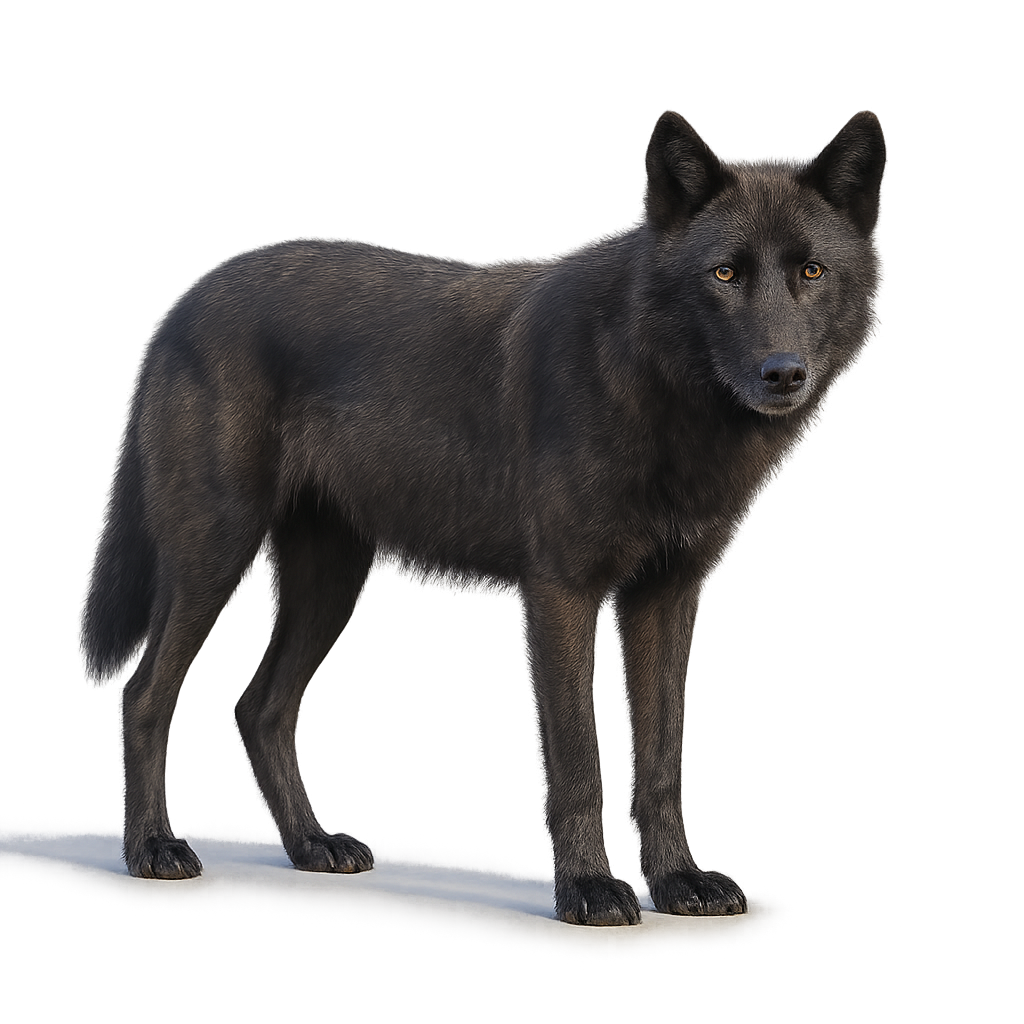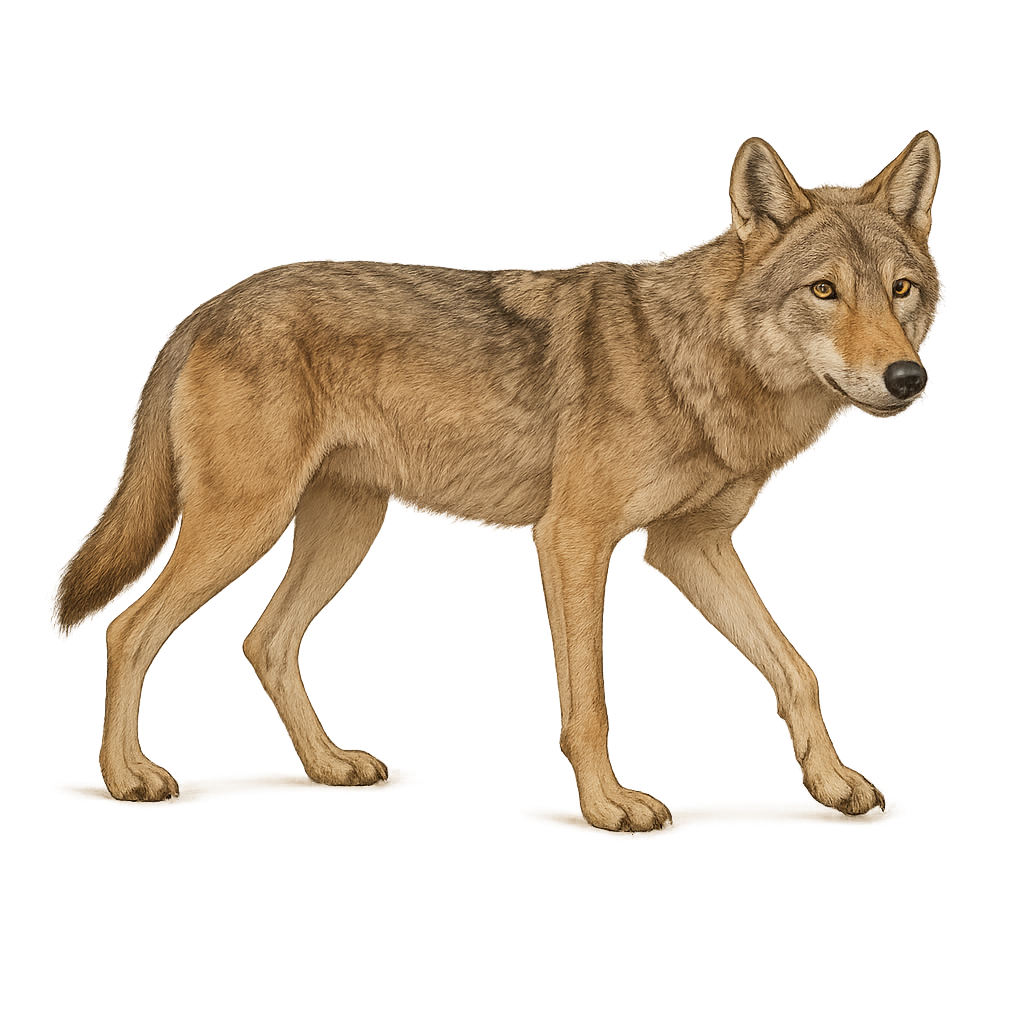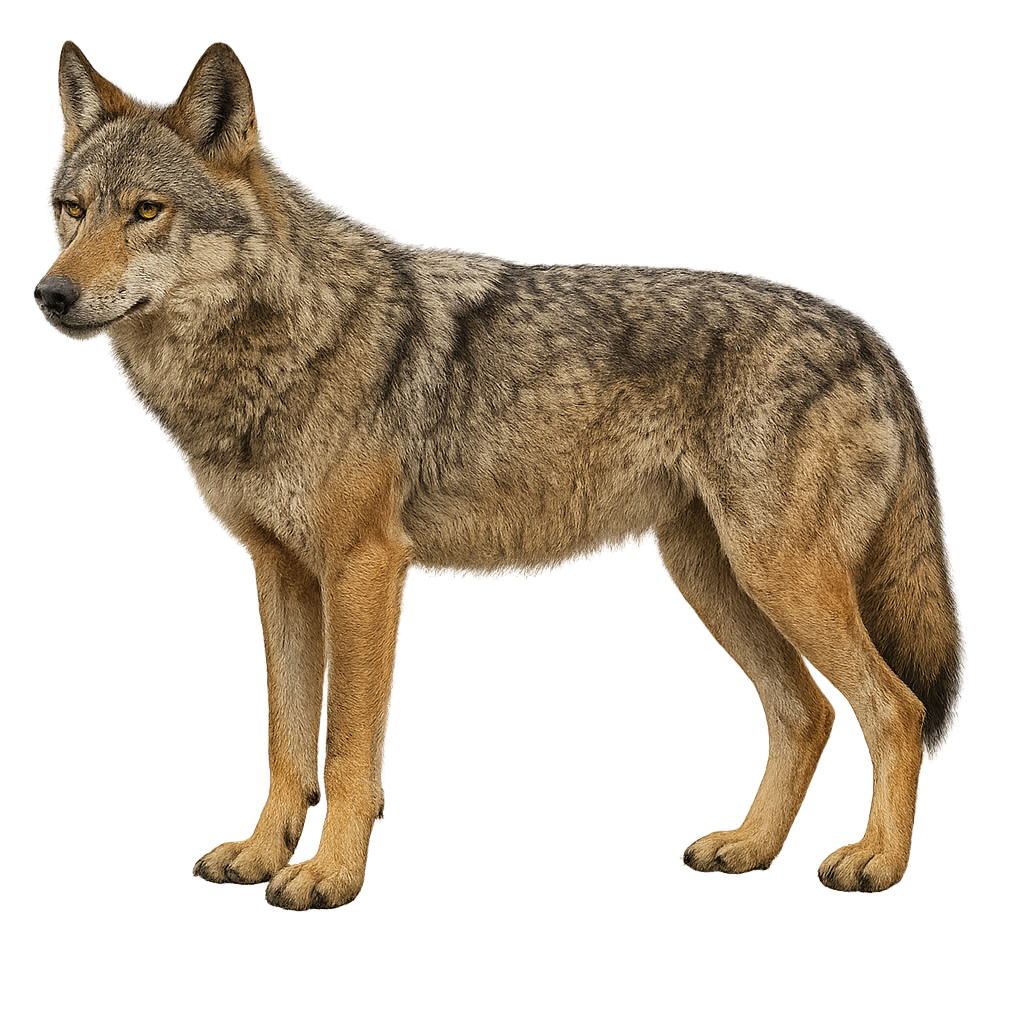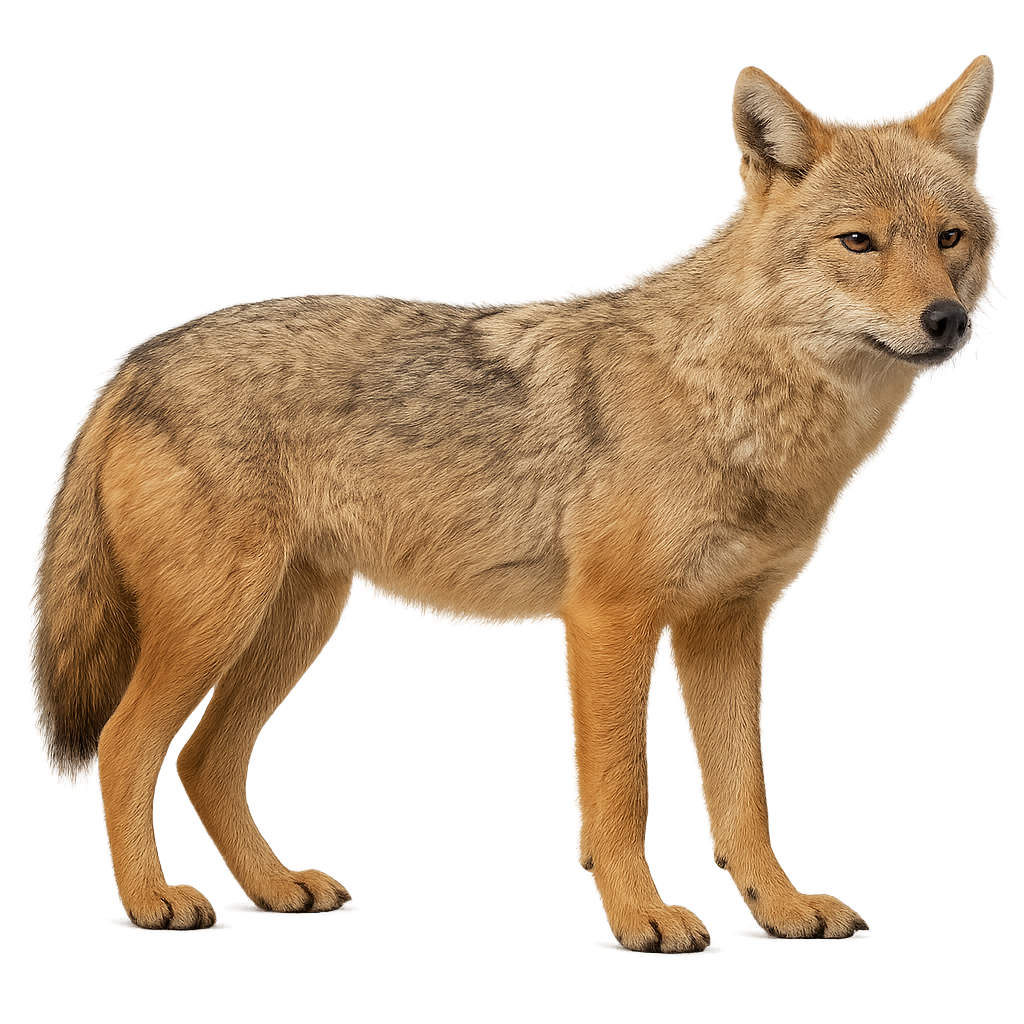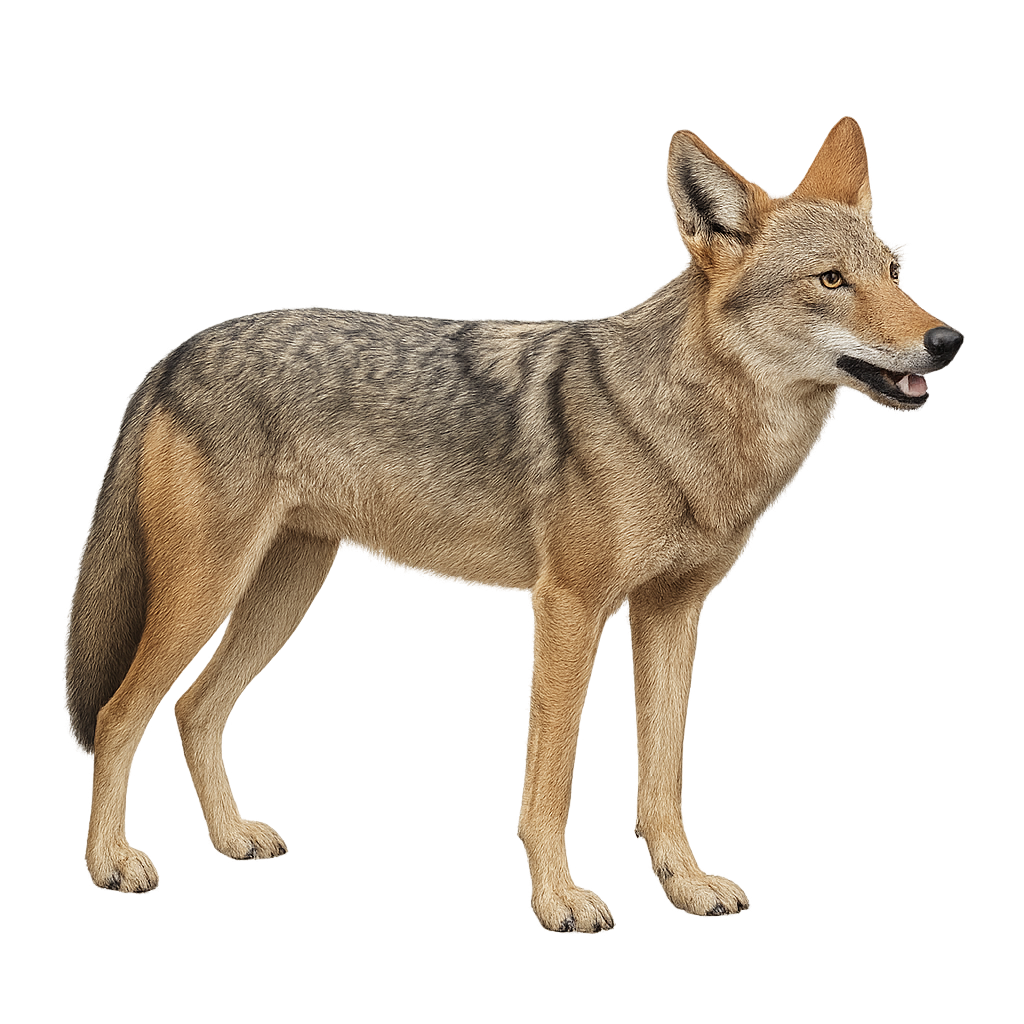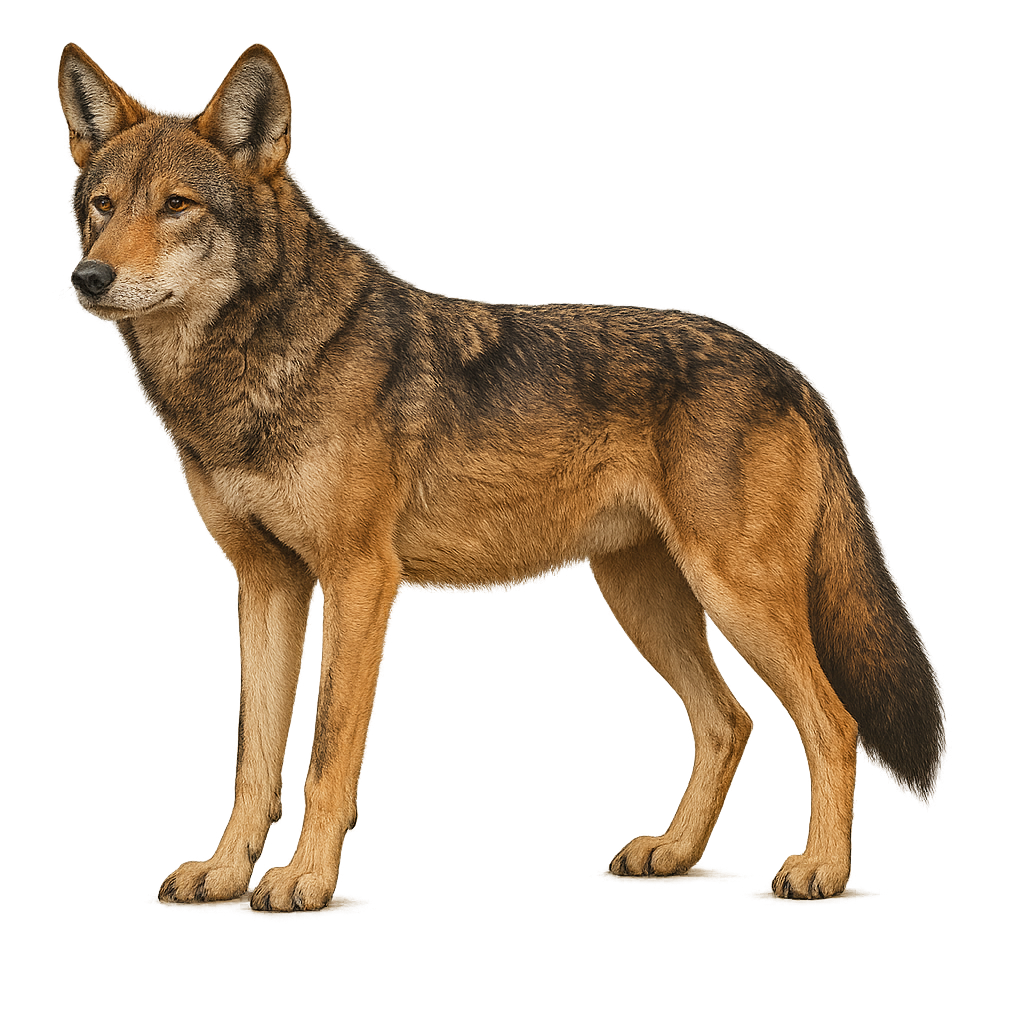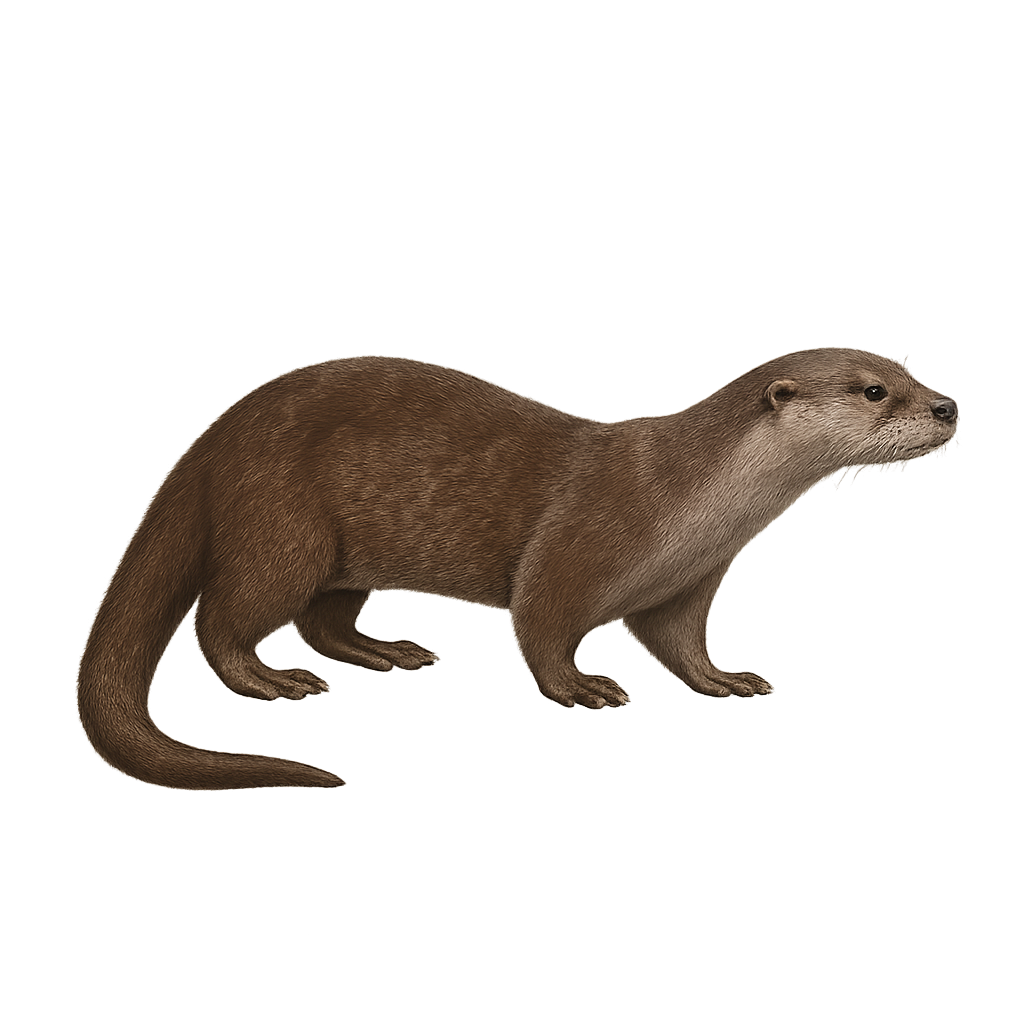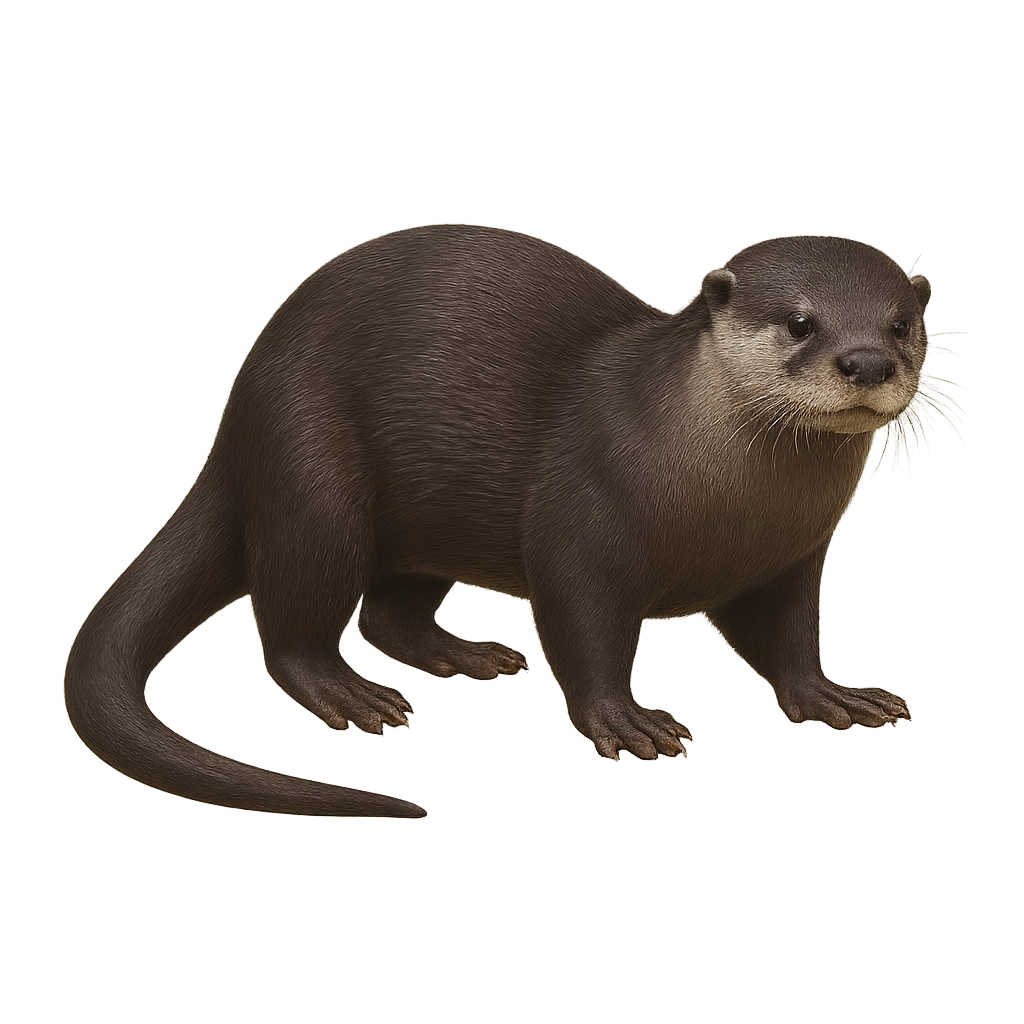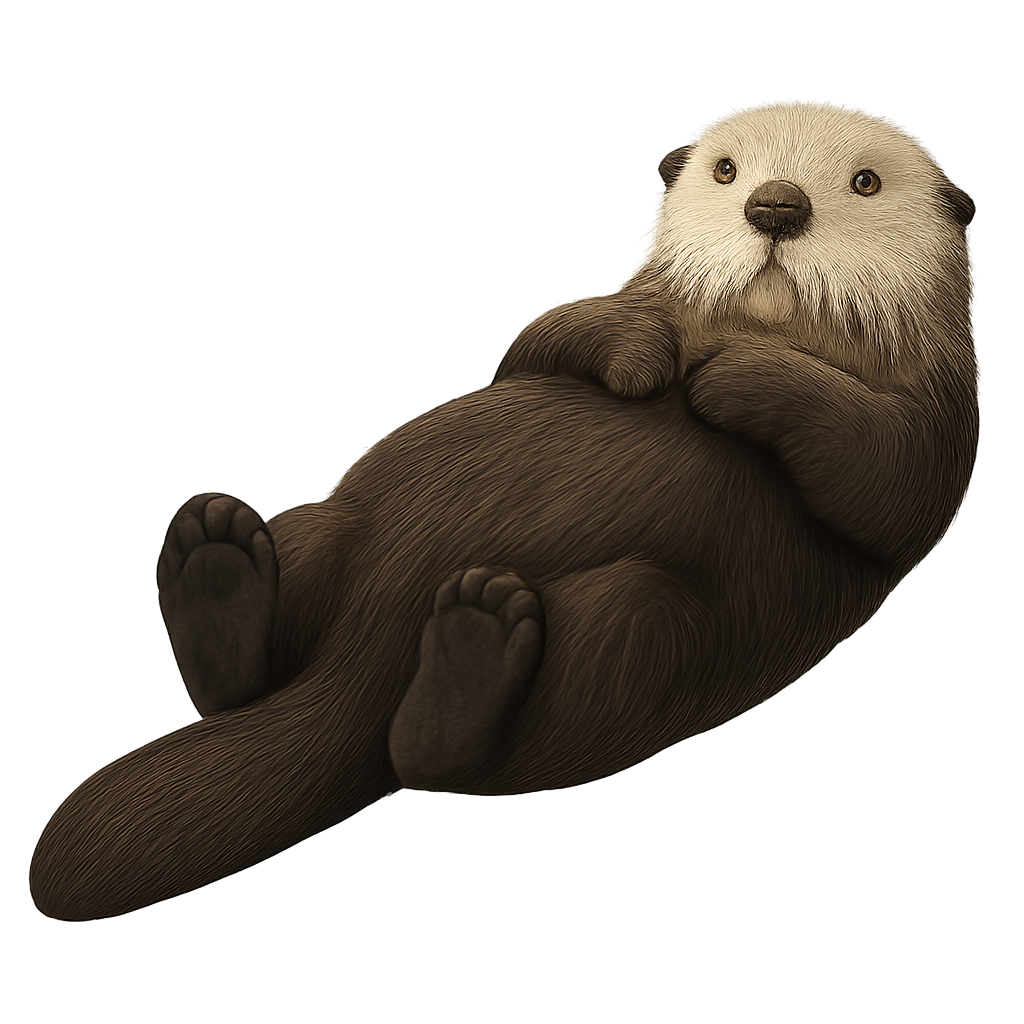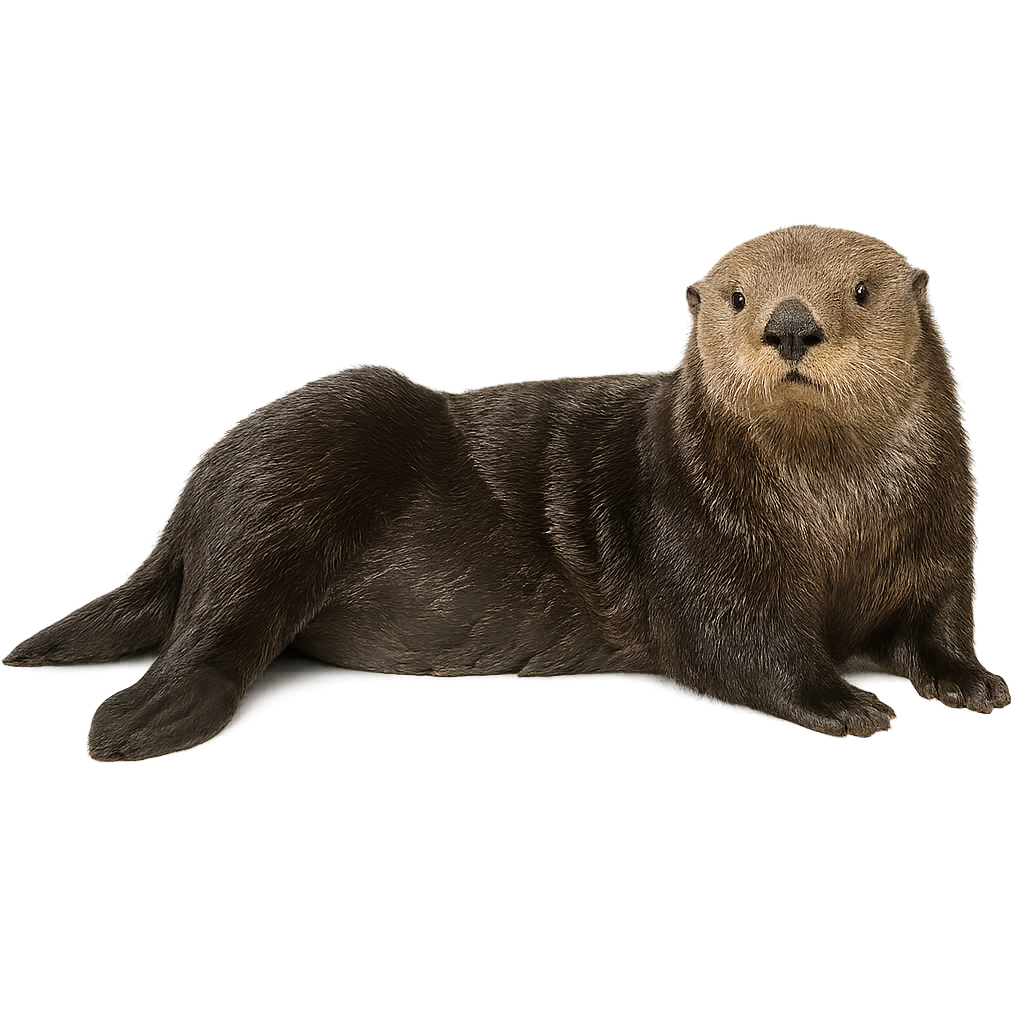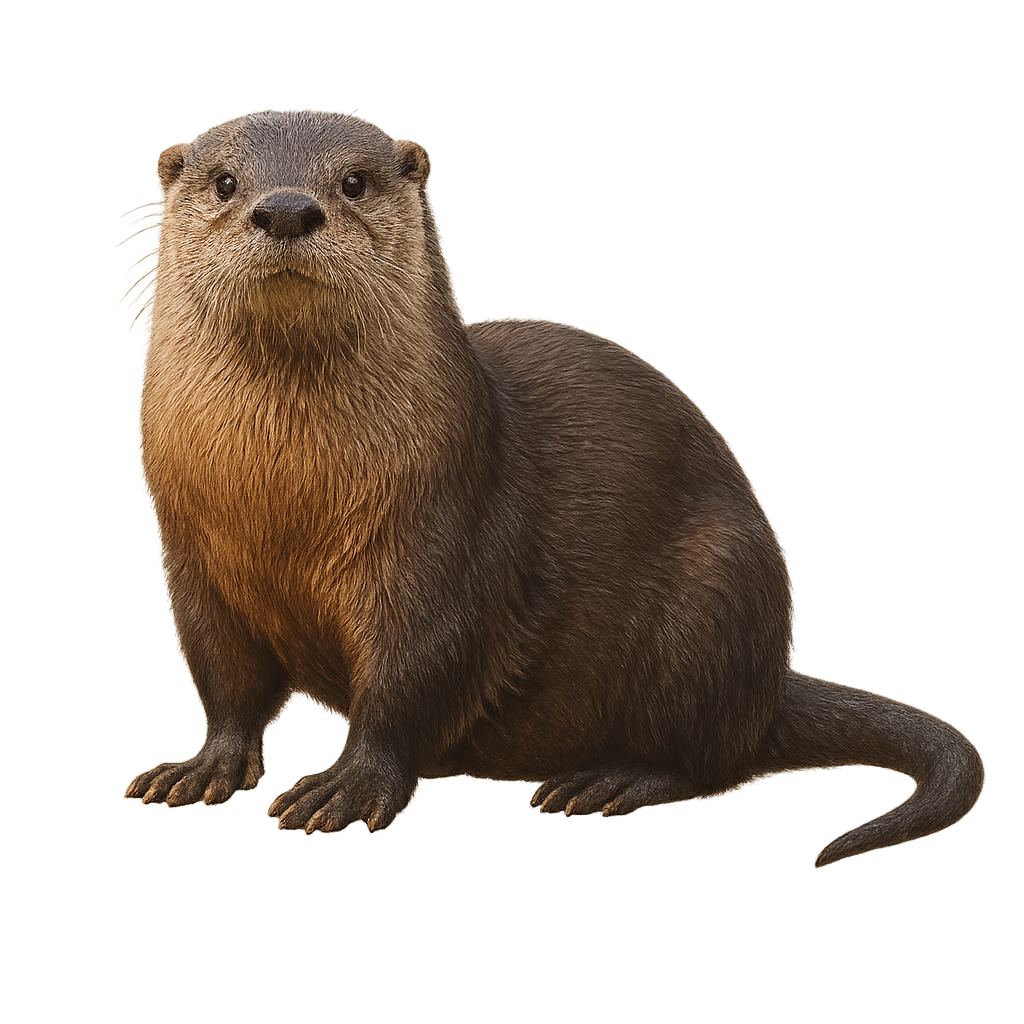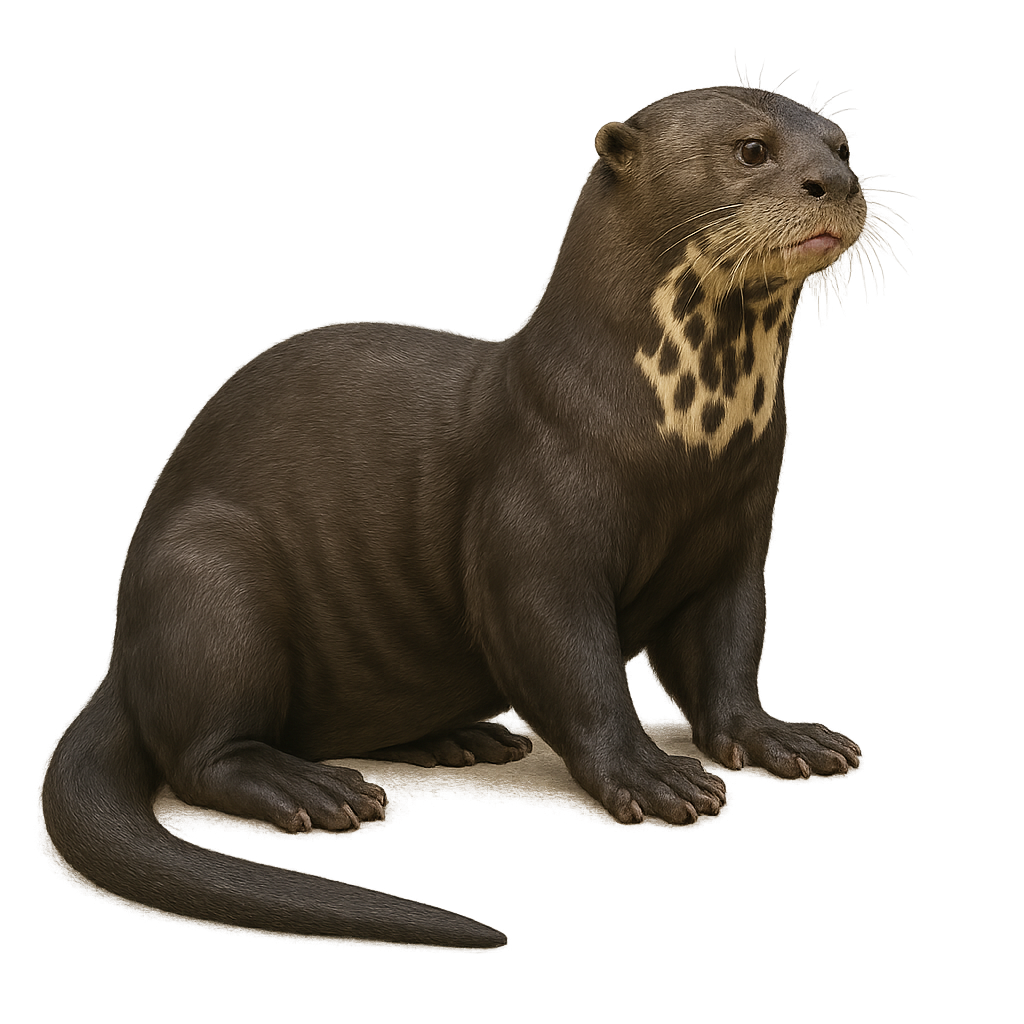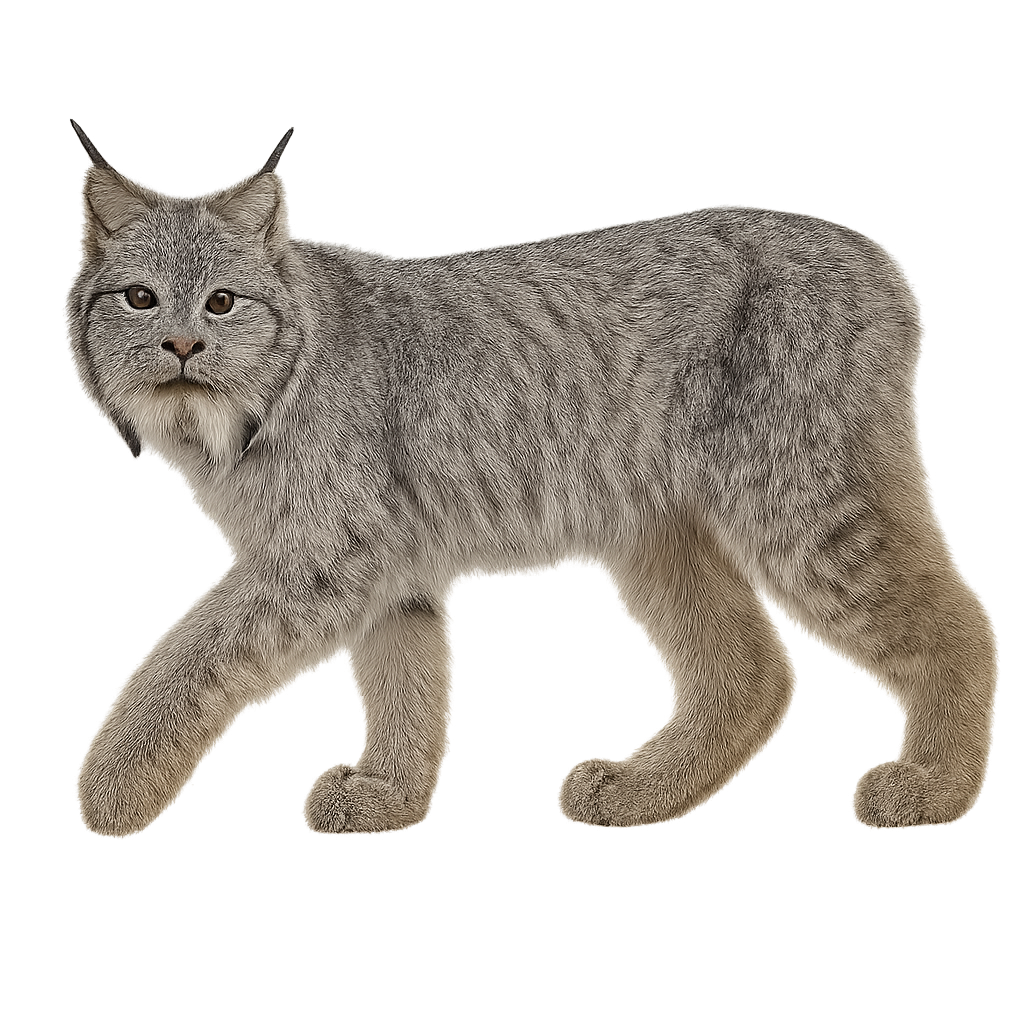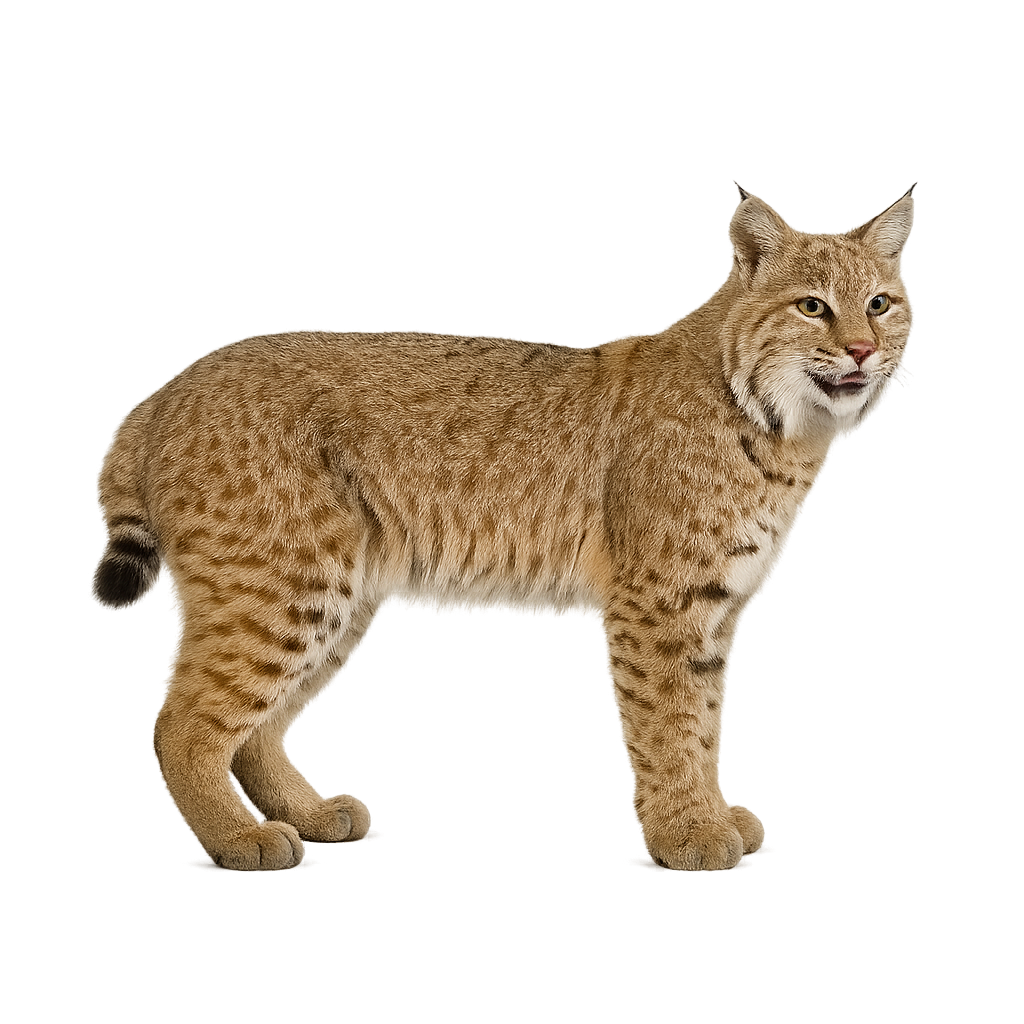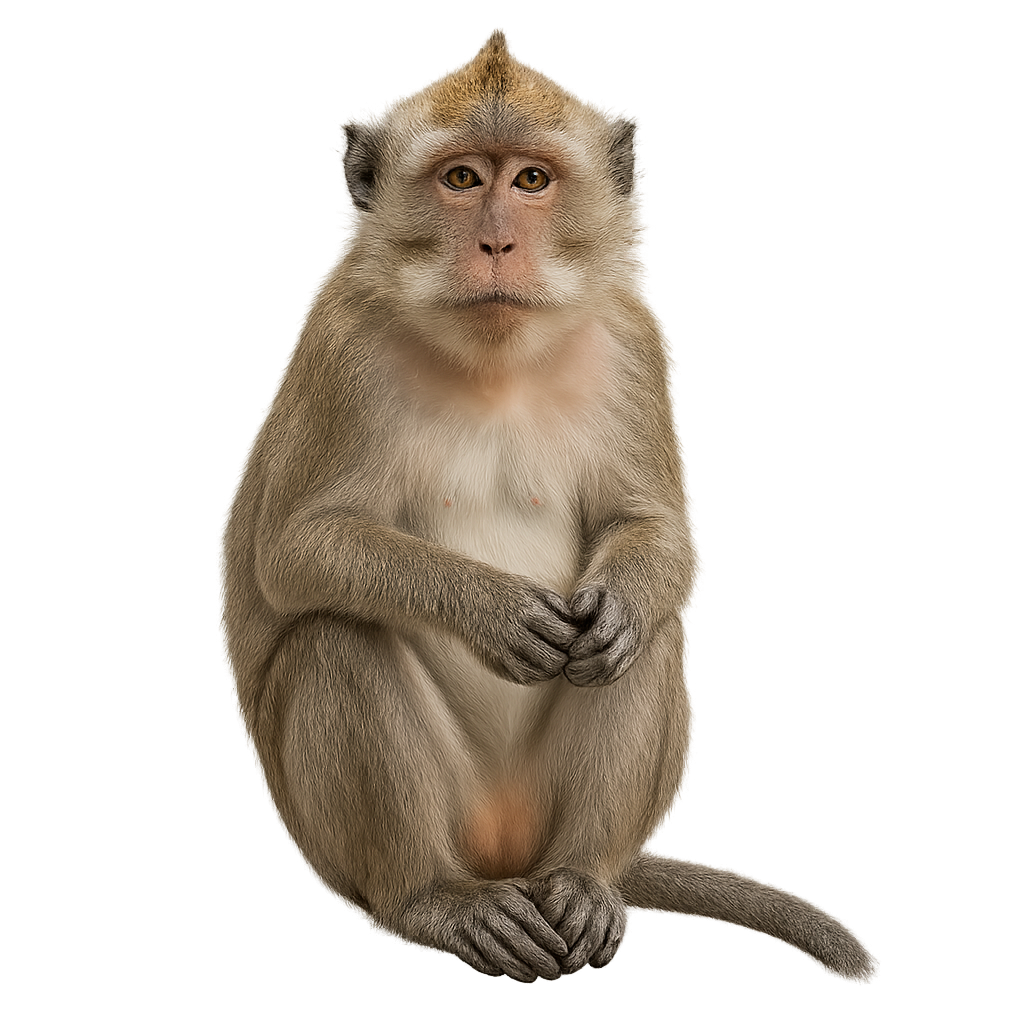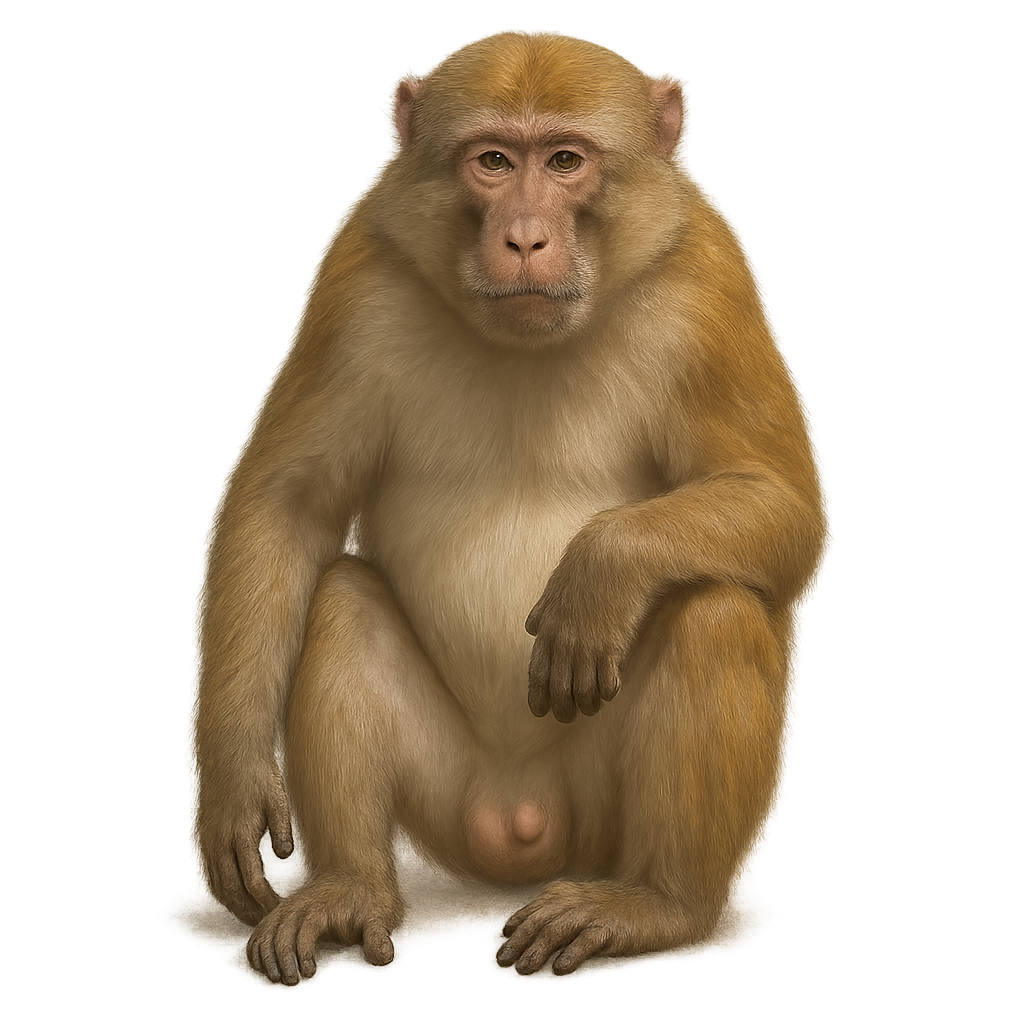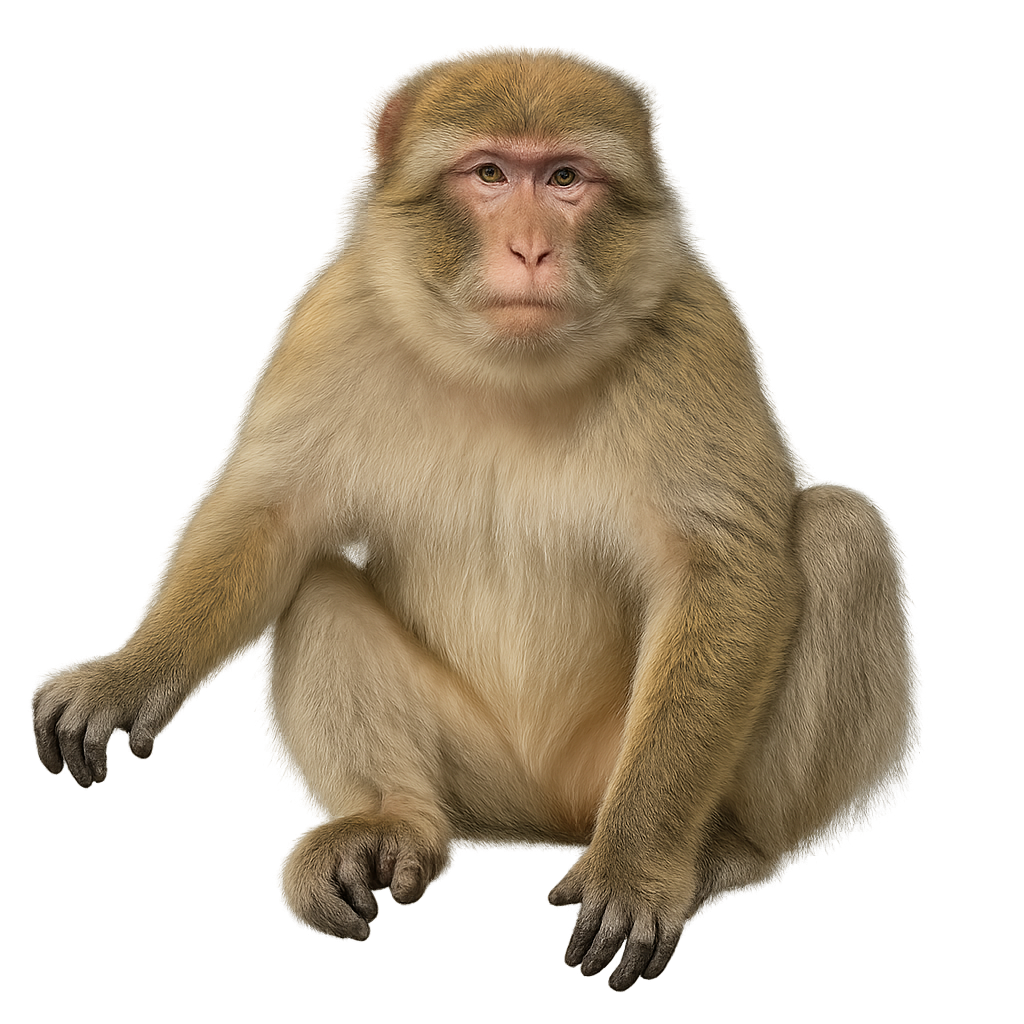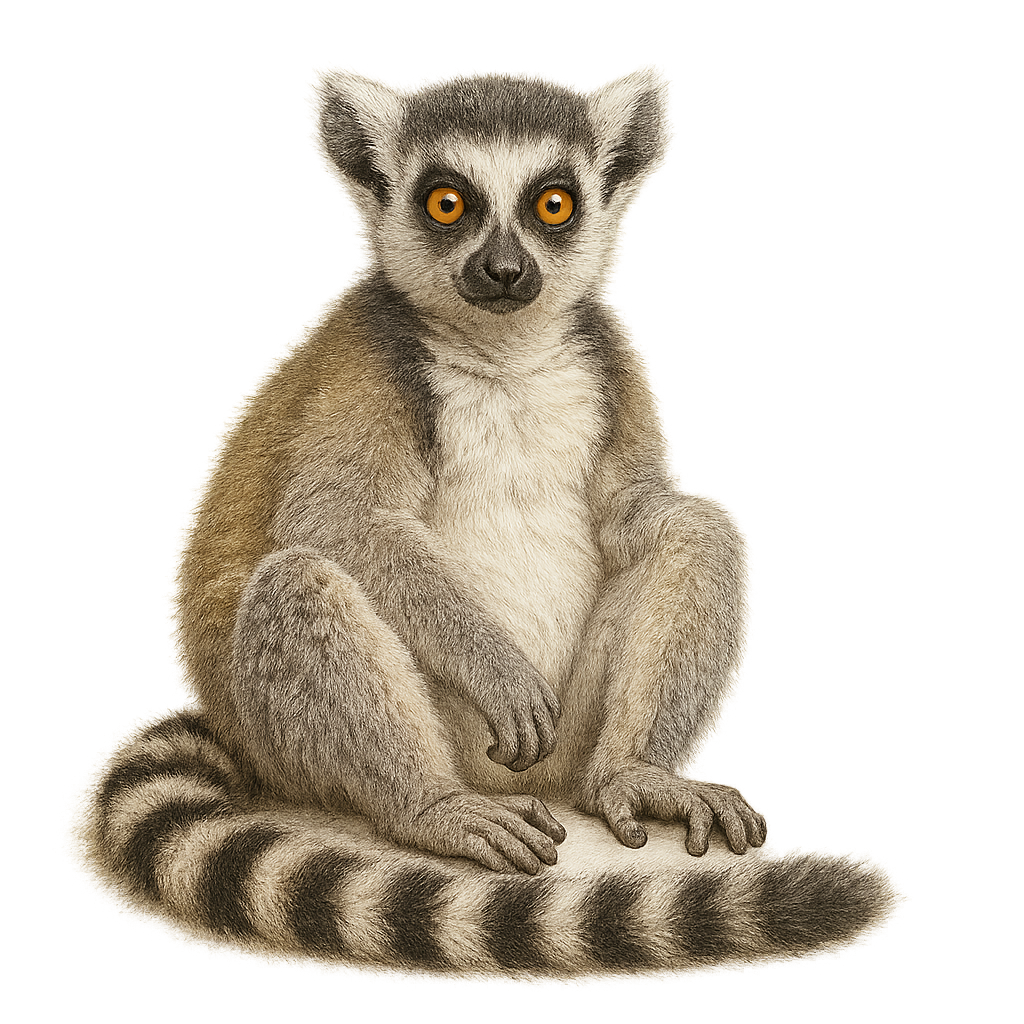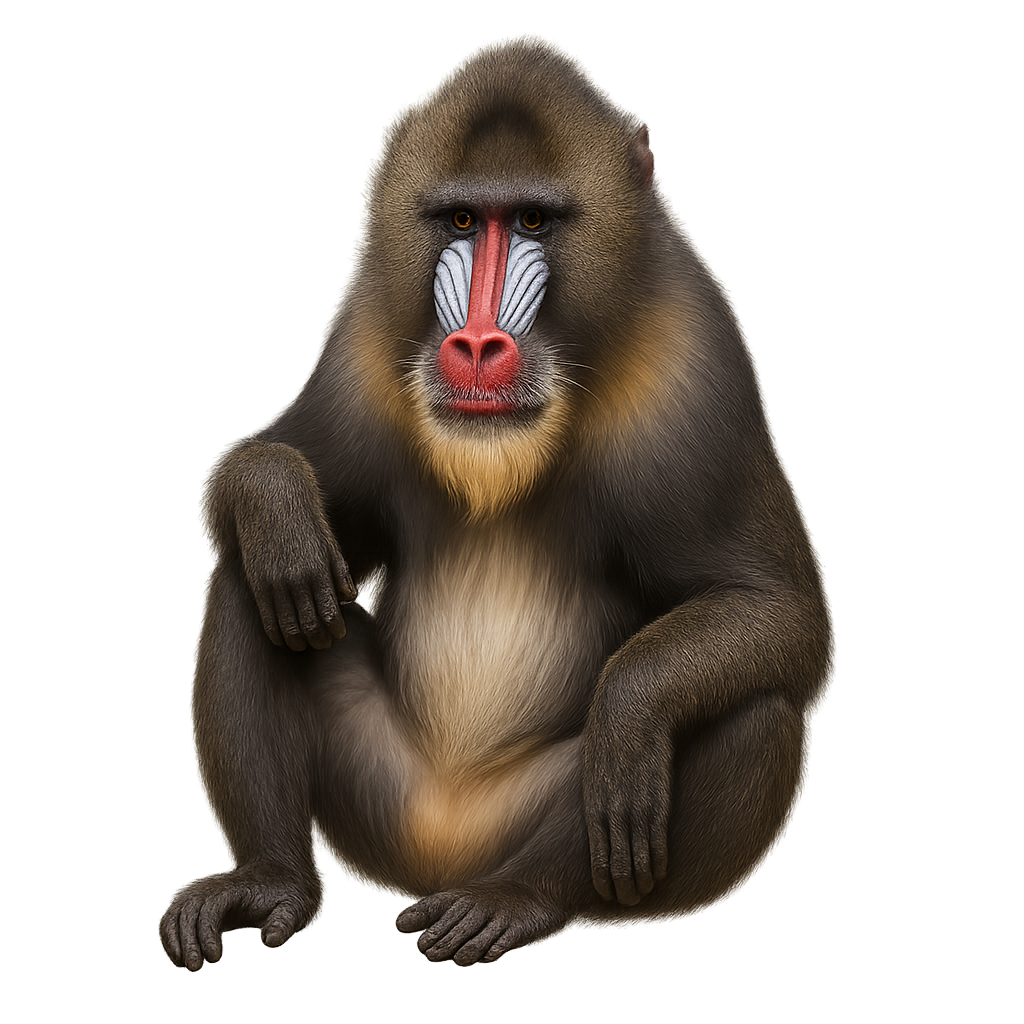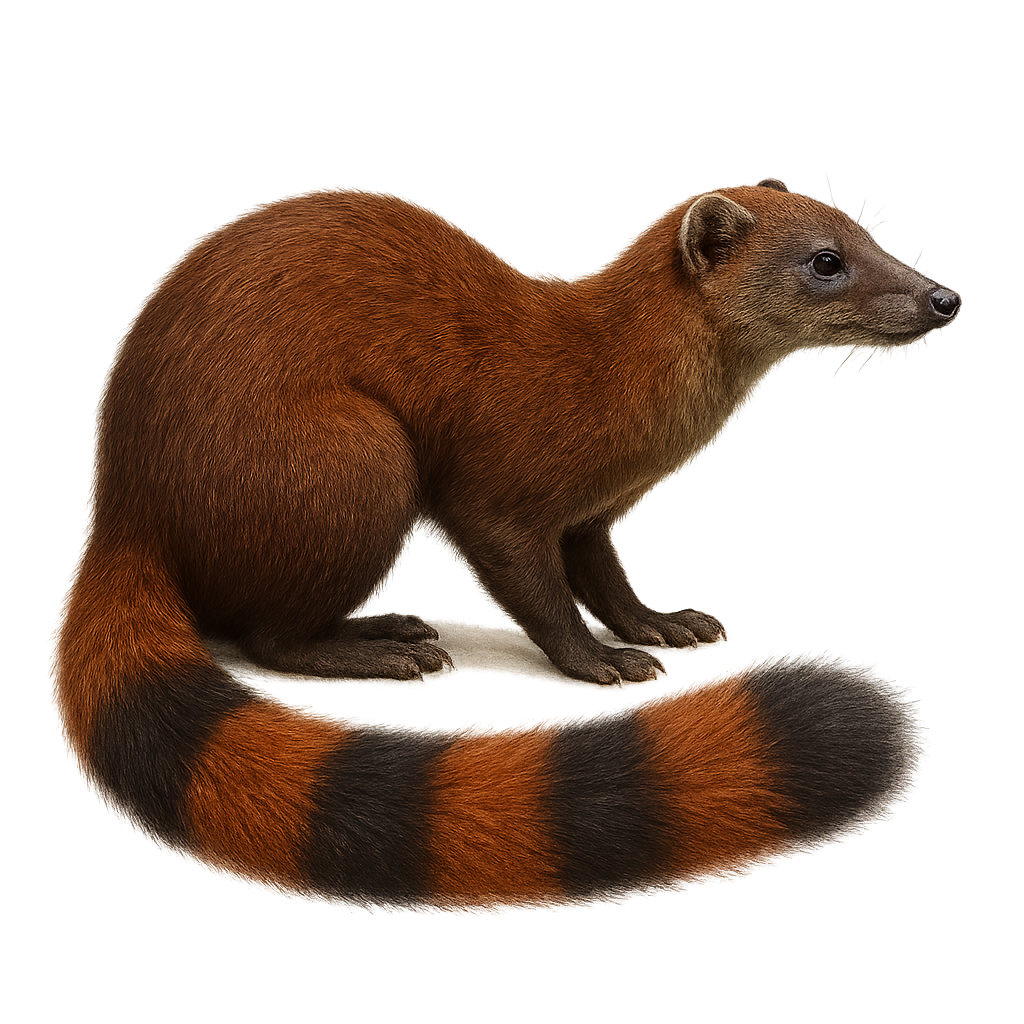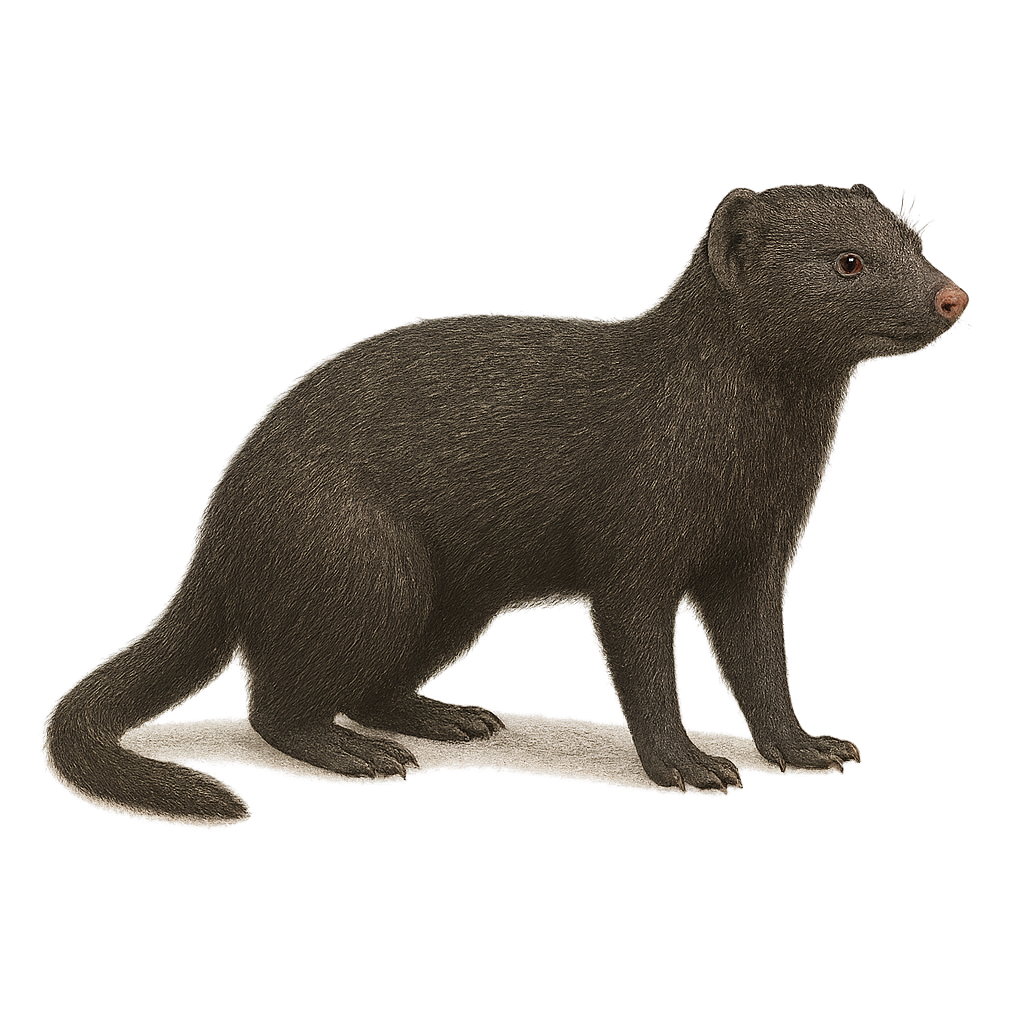The Canis lupus pambasileus, commonly known as the Alaskan wolf, is a subspecies of the gray wolf primarily inhabiting the wild regions of Alaska and the Yukon. Known for its large size and thick fur, this wolf is well adapted to the harsh climatic conditions of its habitat. It lives in structured packs, allowing it to efficiently hunt large prey such as caribou and moose. The Alaskan wolf plays a crucial role in the ecosystem by regulating prey populations. Although generally wary of humans, it can be observed from a distance in national parks. Its conservation is vital for maintaining the ecological balance of its environment.
The Eastern Wolf is a subspecies of the gray wolf, primarily found in the regions of Eastern Europe, notably in Poland, Romania, Bulgaria, and Ukraine. It measures about 1.2 to 1.5 meters in length, with a tail of 35 to 45 cm, and weighs between 25 and 45 kg, with males generally being larger and more massive than females. Its coat is thick and generally light gray to dark gray, with brown and white shades on the belly and legs. The Eastern Wolf primarily inhabits forests, mountains, and protected areas, where it hunts prey such as deer, wild boars, roe deer, and sometimes small mammals. It is a social predator, living in packs, and cooperates with other members of its group to capture prey. Although this subspecies has been the subject of conservation programs, it remains vulnerable to hunting, habitat loss, and conflicts with humans.
The Coastal Wolf is a subspecies of the gray wolf primarily found along the coasts of Alaska and the North Pacific, as well as on certain islands. This wolf is adapted to its coastal environment, where it primarily hunts marine prey such as seals, fish, and seabirds. It measures about 1.3 to 1.5 meters in length, with a tail of about 30 to 40 cm, and weighs between 30 and 50 kg. Its coat is typically gray, brown, or black, with lighter shades on the belly and a thick mane around the neck. The Coastal Wolf is a social predator that lives in family groups and hunts in packs, often in areas close to water or on beaches. In addition to marine prey, it may also feed on deer, bears, and small mammals. While this subspecies is less widespread than others, it is well adapted to its environment and plays an important role in maintaining the balance of coastal ecosystems. However, it is threatened by habitat loss, human disturbances, and hunting.
The Canis lupus pallipes, commonly known as the Indian wolf, is a subspecies of the gray wolf found primarily in the semi-arid regions of India and Pakistan. This medium-sized wolf is characterized by its lighter and shorter coat, adapted to hot climates. It typically lives in small packs and preys on a variety of animals, from small mammals to birds. Although an efficient predator, it is threatened by habitat loss and human conflict. Its adaptability to various environments demonstrates its resilience, yet its population remains vulnerable.
The Italian wolf, or Canis lupus italicus, is a subspecies of the gray wolf, mainly found in the Apennines and Italian Alps. It is characterized by its medium size, dense coat, and color ranging from gray to brown. This predator plays a crucial role in the ecosystem by regulating ungulate populations. Although it was threatened with extinction in the 20th century, conservation efforts have led to an increase in its population. The Italian wolf lives in packs, with a well-defined social hierarchy. It is primarily nocturnal and crepuscular, hunting in groups to optimize its chances of success. Its communication relies on vocalizations, visual, and olfactory signals.
The Golden Wolf is a medium-sized canid native to the Middle East and certain regions of East Africa. It measures about 1.2 to 1.5 meters in length, including its tail, and weighs between 11 and 20 kg. Its coat is generally golden yellow or light brown, with black markings on its back and legs, and lighter shades on its belly. It has long, pointed ears and a narrow, elongated head. The Golden Wolf is primarily carnivorous, feeding on small mammals, birds, reptiles, and sometimes fruits. It lives in family groups or small packs and often hunts cooperatively with other members of the group. The Golden Wolf prefers open areas such as savannas, steppes, and mountains and is particularly adapted to semi-arid environments. Although the species is not immediately endangered, it is threatened by habitat loss, human conflict, and competition with larger carnivores such as jackals and lions.
The Canis lupus lupaster, commonly known as the African golden wolf, is a medium-sized canid primarily inhabiting the northern and eastern regions of Africa. It has a dense, golden coat, often interspersed with gray or silver hues, allowing it to blend into the arid and semi-arid landscapes it frequents. This opportunistic predator feeds on a variety of prey, ranging from small mammals to birds, and does not hesitate to scavenge. Although often solitary, it can form pairs or small packs for hunting. Its adaptable behavior and ability to thrive in diverse environments make it a remarkable survivor.
The Gray Wolf is a large carnivore, often considered the ancestor of all modern subspecies of wolves. It measures between 1.2 and 1.8 meters in length, with a tail of 30 to 50 cm, and weighs between 25 and 40 kg, though some individuals can reach 70 kg. Its coat is typically gray, but it can also include shades of white, brown, and black depending on the region and season. The Gray Wolf lives in a variety of habitats, from deep forests to tundra regions, and from mountains to plains. It is a social predator that lives in packs, cooperating with other members of its group to hunt prey such as deer, elk, bison, and other large mammals. The Gray Wolf plays an essential role in ecosystem balance by regulating herbivore populations. Although it is protected in many areas, it remains threatened by habitat loss, hunting, and conflicts with humans.
The red wolf, Canis rufus, is a medium-sized canid native to the United States. It is characterized by its reddish-brown coat, pointed ears, and bushy tail. Historically, it occupied a wide range of habitats, from coastal marshes to deciduous forests. However, habitat loss and excessive hunting have significantly reduced its population. Today, it is primarily confined to protected areas. The red wolf is an opportunistic predator, feeding on small mammals, birds, and occasionally deer. It lives in packs structured around an alpha pair. Conservation efforts aim to reintroduce this species into its natural habitat and raise public awareness of its ecological importance.
The Neotropical Otter, or Lontra longicaudis, is a semi-aquatic mammal found primarily in the rivers and lakes of Central and South America. It is recognizable by its sleek body, dense waterproof fur, and long muscular tail. Measuring between 90 and 150 cm, it typically weighs from 5 to 15 kg. This species is known for its playful and curious behavior, often seen sliding down banks or diving in search of fish, crustaceans, and other small aquatic animals. Although mainly solitary, it can sometimes be seen in small family groups. The Neotropical Otter is an important indicator of aquatic ecosystem health, as it requires clean waters rich in prey.
The smooth-coated otter, Lutrogale perspicillata, is a semi-aquatic mammal belonging to the Mustelidae family. It is recognizable by its dense, smooth fur, typically dark brown on the back and lighter on the belly. This species is primarily found in South and Southeast Asia, inhabiting rivers, lakes, and swamps. It is well adapted to aquatic life with its webbed feet and muscular tail, allowing it to swim gracefully. The smooth-coated otter is a social animal, often living in family groups. It primarily feeds on fish but can also consume crustaceans and small mammals. Although its conservation status is concerning due to habitat loss and pollution, it plays a crucial role in the aquatic ecosystem.
The African clawless otter is a semi-aquatic mustelid, 60–100 cm long, with dark brown fur and a paler throat. Found across tropical and subtropical sub-Saharan Africa, it inhabits rivers, lakes, swamps, and estuaries. An excellent swimmer, it feeds on fish, crustaceans, and molluscs, diving skillfully to capture its prey.
The Eurasian Otter is a semi-terrestrial aquatic mammal found primarily in rivers, lakes, and coastal areas of Eurasia. It measures between 60 and 90 cm in length, with a tail of about 30 to 40 cm, and weighs between 5 and 12 kg. Its coat is thick and waterproof, dark brown on the back and lighter on the belly, allowing it to stay warm and move easily in the water. The Eurasian Otter is an excellent swimmer, using its hind limbs to propel itself and its tail to stabilize. It primarily feeds on fish but can also hunt amphibians, crustaceans, and small mammals. It is a solitary animal or lives in small family groups, marking its territory with traces and droppings. Although the species is protected in many areas, it is threatened by water pollution, habitat loss, and poaching.
The Sea Otter is a marine aquatic mammal primarily found along the coasts of the Pacific Ocean, particularly in North America and Northeast Asia. It measures between 1 and 1.5 meters in length, with a short tail of about 30 cm, and weighs between 14 and 45 kg, with females generally being smaller than males. Its coat is extremely dense and waterproof, with fine hairs that help it stay warm in the cold ocean waters. Unlike many other marine mammals, the Sea Otter does not have a layer of fat beneath its skin, making its fur all the more crucial for survival. This carnivore primarily feeds on shellfish, crustaceans, mollusks, fish, and sea urchins, often using rocks as tools to open them. The Sea Otter often lives in family groups called "rafts," floating together on the water's surface. Although it is protected in many areas, the Sea Otter is still threatened by pollution, habitat loss, and hunting.
The Enhydra lutris kenyoni, or northern sea otter, is a fascinating marine mammal known for its dense fur and playful behavior. It primarily inhabits the North American coasts, from Alaska to British Columbia. These otters are skilled divers, feeding on mollusks, crustaceans, and fish. They play a crucial ecological role by regulating sea urchin populations, thus preserving kelp forests. Sea otters are often seen floating on their backs, using stones to open shells. Although their population was decimated by hunting for their fur, conservation efforts have led to some recovery. However, they remain vulnerable to oil spills and climate change.
The North American River Otter, or Lutra canadensis, is a semi-aquatic mammal belonging to the Mustelidae family. It is recognizable by its streamlined body, webbed feet, and muscular tail. Its thick, waterproof fur ranges from dark brown to silvery gray. Measuring between 90 and 135 cm, it typically weighs 5 to 14 kg. Adapted to aquatic life, it is an agile and fast swimmer. It primarily feeds on fish, but also consumes crustaceans, amphibians, and small mammals. The river otter is a social animal, often observed in family groups. It plays a crucial role in the ecosystem by regulating fish populations and maintaining the health of waterways.
The giant otter (Pteronura brasiliensis) is a semi-aquatic mustelid measuring 1.5–1.8 m in length (including tail) and weighing 22–32 kg. It inhabits slow-moving rivers, marshes, and floodplain lakes in tropical South America from the Orinoco to the Amazon. Highly social, it lives in family groups of 4–20 individuals, digs riverbank dens, and uses loud vocalizations. A specialist carnivore, it hunts fish and crustaceans by diving, propelled by its powerful tail. Females give birth in the dry season (August–September), and group members reinforce bonds through mutual grooming.
The African Wild Dog is an exceptional social predator, easily recognized by its unique spotted coat, which ranges in color from yellow-orange to black, with irregular markings. It has large, rounded ears and an expressive face. This carnivore primarily lives in organized packs, which allow it to effectively hunt large mammals such as gazelles and impalas. Their hunting strategy is based on cooperation, speed, and endurance, with long and energetic chases.
The African Wild Dog is also known for its social behavior, with pack members maintaining strong bonds through vocalizations, play, and grooming rituals. Unfortunately, this species is endangered due to habitat loss, illegal hunting, and conflicts with humans. It is a protected species, and efforts are underway to preserve remaining populations in wildlife reserves.
The Canada Lynx is a medium-sized cat characterized by its thick paws and large pointed ears adorned with black tufts of fur. It measures about 80 to 105 cm in length, with a short tail of about 10 to 15 cm, and weighs between 8 and 14 kg. Its coat is generally light gray to reddish-brown, with darker spots on the flanks and a lighter underside. The Canada Lynx primarily inhabits the boreal forests of North America, particularly in Canada and northern parts of the United States. It primarily feeds on hares, particularly the Snowshoe Hare, but may also hunt small mammals, birds, and fish. This solitary predator is known for its great stealth and ability to blend into its snowy environment. While the species remains relatively stable, it faces threats such as habitat loss, competition with other predators, and the impacts of climate change.
The Iberian Lynx is a medium-sized cat endemic to the Iberian Peninsula, primarily found in southern Spain and Portugal. It measures about 80 to 100 cm in length, with a tail of about 10 to 15 cm, and weighs between 8 and 14 kg, with males generally being larger than females. Its coat is pale beige to light brown, with darker spots on the back and flanks, and a lighter underside. It has pointed ears, adorned with tufts of black fur, and a small beard on its chin. The Iberian Lynx primarily inhabits wooded and semi-desert areas, where it hunts prey such as hares, birds, and especially ungulates like deer and rabbits, which are its main food source. This solitary predator is highly territorial and uses calls and claw marks to demarcate its territory. Although it is one of the most endangered cats in the world, conservation efforts have helped increase its population, but it remains vulnerable to habitat loss and the decline of its natural prey.
The Bobcat is a medium-sized cat native to North America, where it is widespread, particularly in the United States, Canada, and Mexico. It measures about 80 to 110 cm in length, with a short tail of 10 to 15 cm, and weighs between 8 and 14 kg, although some males can reach 20 kg. Its coat is typically tawny or grayish with dark spots, and it has black tufts of fur on its ears, a characteristic feature of this species. The Bobcat is an excellent solitary hunter, primarily feeding on hares, rabbits, as well as birds and small mammals. It is particularly known for its ability to hunt in a variety of environments, ranging from dense forests to more open regions. This predator uses its great stealth to approach its prey before launching a quick attack. While the Bobcat remains relatively stable in terms of population, it is threatened by habitat loss and illegal hunting in some areas.
The Black-faced macaque is a primate native to the islands of Sulawesi in Indonesia. It is recognizable by its distinctive black face and gray or brown fur. This macaque is primarily frugivorous but also feeds on insects and small animals. It lives in complex social groups, often near rivers and tropical forests. The species is threatened by deforestation and the loss of its natural habitat.
The crab-eating macaque is a semi-terrestrial primate 40–60 cm long (excluding tail) with a long tail and grey-brown fur. It inhabits mangroves, primary and secondary forests, agricultural and urban areas of Southeast Asia, feeding on crabs, fruits, seeds and small invertebrates. Breeding occurs year-round, with groups led by a dominant male and each female giving birth to a single offspring.
The Assam macaque, or Macaca assamensis, is a medium-sized primate native to the forests of Southeast Asia. It is characterized by its gray-brown fur and pink face, often surrounded by a lighter beard of hair. This monkey lives in complex social groups led by a dominant male. It is primarily arboreal but often descends to the ground to forage. An omnivore, its diet includes fruits, leaves, insects, and small animals. The Assam macaque plays a crucial role in seed dispersal, thus contributing to the health of its ecosystem. Unfortunately, it is threatened by deforestation and hunting, leading to a decline in its populations.
The Barbary macaque is a large Old World monkey, measuring 55–75 cm in body length and weighing 10–18 kg, with greyish-brown fur and a paler crown. Endemic to the Atlas Mountains of Morocco and Algeria, it inhabits cedar forests, scrub and rocky slopes, feeding on fruits, leaves and insects. Social and matriarchal, it lives in family groups where males uniquely assist in infant care. During the breeding season (01.11-31.03), males display dominance through chest-posturing and vocal calls.
The Ring-tailed lemur is an iconic lemur from Madagascar, easily recognizable by its long, black and white ringed tail. It primarily inhabits dry forests and rocky areas in the south of the island. This social primate lives in matriarchal groups that can number up to 30 individuals. Active during the day, it spends much of its time foraging for food, mainly fruits, leaves, and flowers. The Ring-tailed lemur is also known for its morning sunbathing, sitting facing the sun to warm up. Unfortunately, this species is threatened by deforestation and hunting, leading to a decline in its wild population.
The mandrill, Mandrillus sphinx, is a fascinating primate known for its spectacular appearance and complex social behaviors. Native to the tropical forests of Central Africa, it is primarily found in Gabon, Cameroon, and Equatorial Guinea. Males are particularly recognizable due to their colorful faces, with vivid shades of blue and red, and their yellow manes. Females and juveniles are more discreet, with less vibrant colors. Mandrills live in social groups called hordes, which can number up to several hundred individuals. They primarily feed on fruits, seeds, insects, and small animals. Although their habitat is threatened by deforestation, they are still relatively numerous in some protected areas.
The ring-tailed mongoose, Galidia elegans, is a small carnivore endemic to Madagascar. It is distinguished by its black and russet ringed tail, giving it a unique appearance. Its fur is primarily reddish-brown, with darker shades on the back. It measures about 32 to 38 cm in length, excluding its tail, which can reach 28 to 33 cm. Agile and lively, it is often observed in the island's humid forests and wooded areas. It primarily feeds on small animals, insects, and fruits. Although its habitat is threatened by deforestation, it is still relatively widespread in some regions.
The bushy-tailed mongoose, or Bdeogale crassicauda, is a small African carnivore belonging to the Herpestidae family. It is characterized by its bushy tail and grayish-brown fur. Primarily nocturnal, it feeds on insects, small vertebrates, and fruits. It inhabits tropical forests, savannas, and wooded areas in East Africa. Although elusive, it is sometimes seen in small family groups. Its ability to adapt to various habitats allows it to survive in changing environments. However, deforestation and habitat loss pose potential threats to its population.




